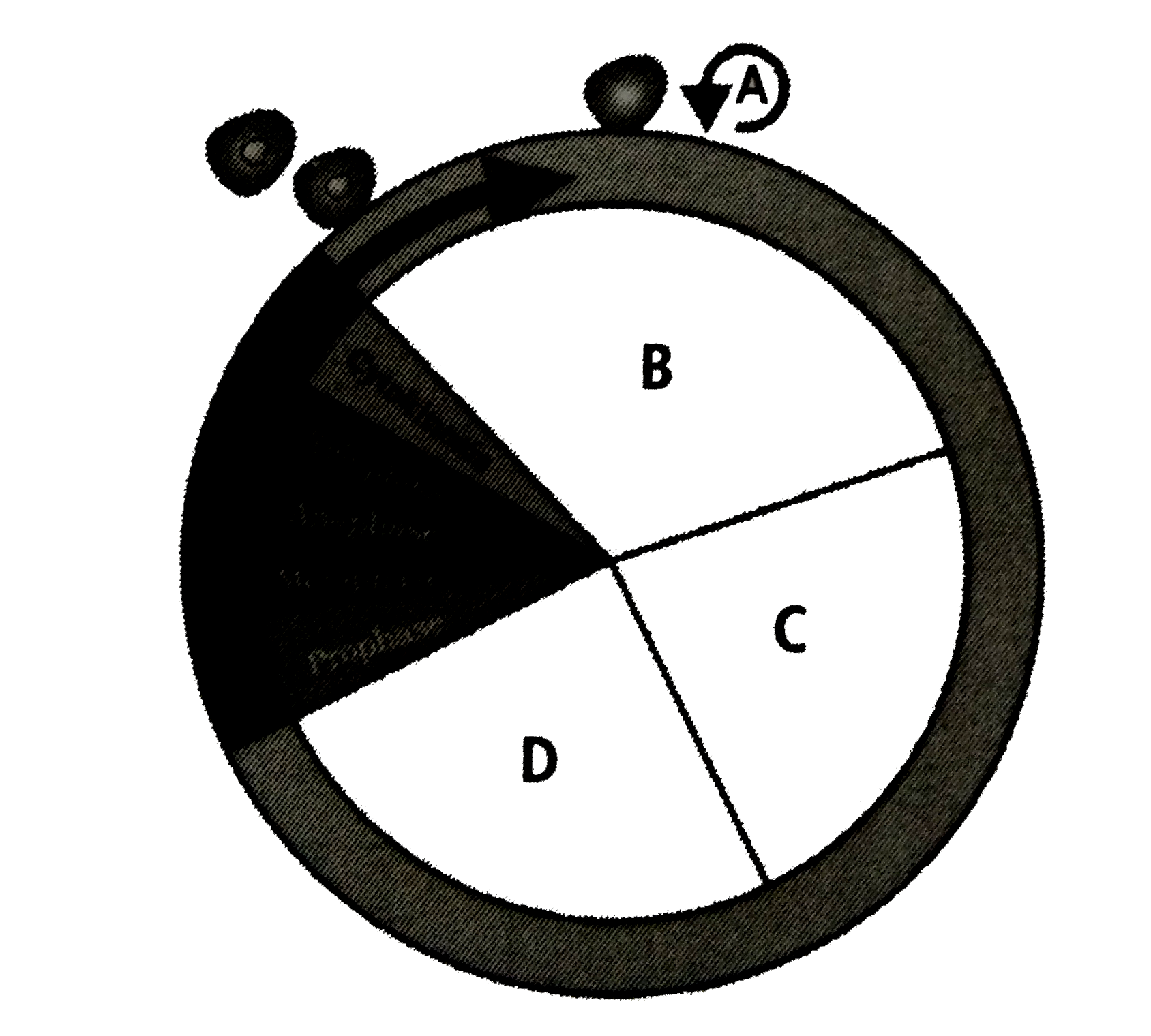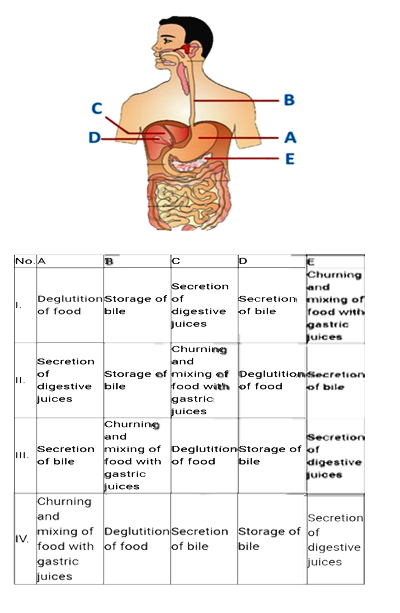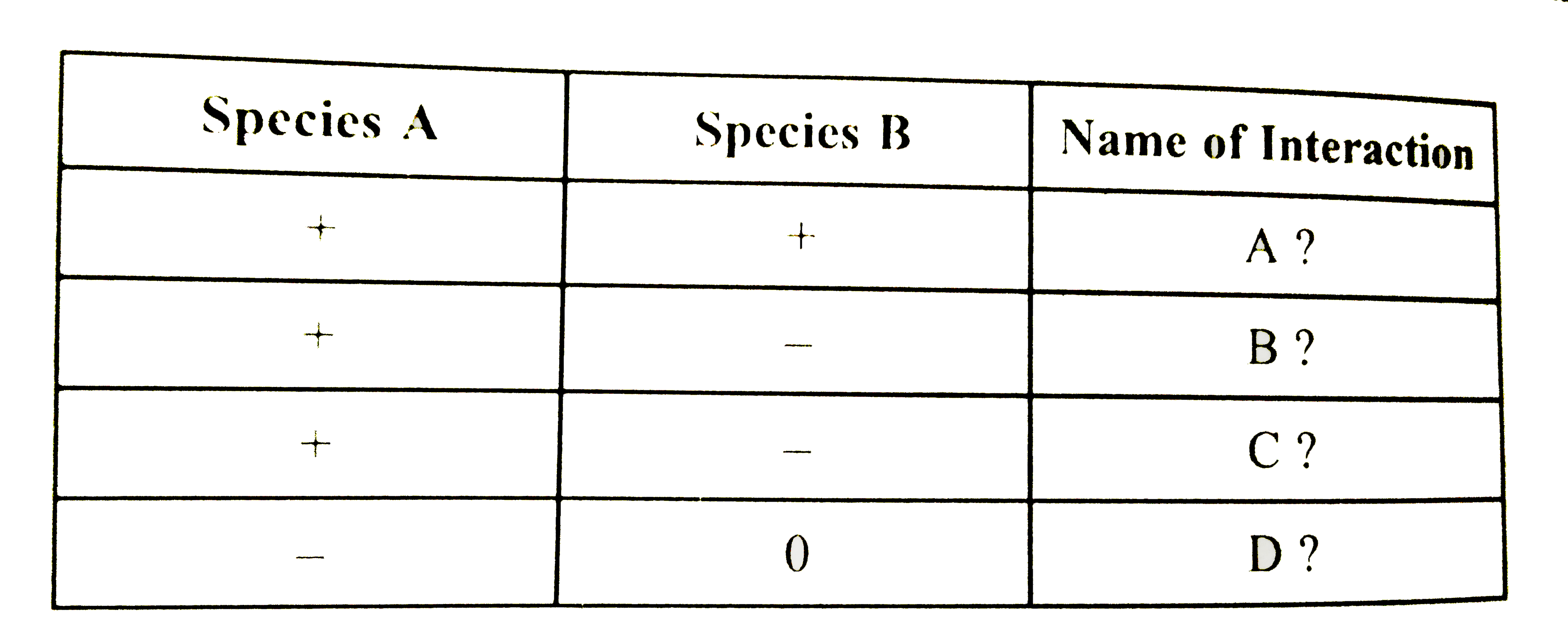Observe the table depicting interactions between various organism and select the correct option :
SpeciesSpeciesName of Interaction ++Mutualism−−A+−B+−Parasitism+0C−0D
(+) Beneficial (-) detrimental (0) Neutral
A : Commensalism , B : Predation , C : Amensalism , D : Amensalism
A : Predation , B : Parasitism , C : Commensalism , D : Amensalism
A : Competition , B : Parasitism , C : Commensalism , D : Amensalism
A : Competition , B : Predation , C : Amensalism , D : Commensalism
The correct Answer is:C
To solve the question regarding the interactions between various organisms based on the provided table, we will analyze each interaction step by step.
1. Identify the Interactions:
- The table provides different interactions characterized by signs: (+,+), (-,-), (+,-), (+,0), and (-,0).
- Each sign represents the nature of the interaction between two species.
2. Analyze Mutualism:
- The first interaction is represented by (+,+), which is known as Mutualism.
- In mutualism, both species benefit from the interaction.
3. Identify Interaction A (-,-):
- The interaction labeled as A shows (-,-).
- This represents Competition, where both species are harmed as they compete for limited resources (e.g., food, space).
4. Identify Interaction B (+,-):
- The interaction labeled as B shows (+,-).
- This interaction can be identified as Predation or Parasitism. In both cases, one species benefits while the other is harmed.
5. Identify Interaction C (+,0):
- The interaction labeled as C shows (+,0).
- This represents Commensalism, where one species benefits while the other is unaffected.
6. Identify Interaction D (-,0):
- The interaction labeled as D shows (-,0).
- This represents Amensalism, where one species is harmed while the other remains unaffected.
7. Summarize the Interactions:
- A: Competition (-,-)
- B: Predation or Parasitism (+,-)
- C: Commensalism (+,0)
- D: Amensalism (-,0)
8. Select the Correct Option:
- Based on the analysis, the interactions are correctly matched with their respective types. The correct option for the question is the one that aligns with these findings.
Final Answer:
The correct option is the one that identifies:
- A: Competition
- B: Predation or Parasitism
- C: Commensalism
- D: Amensalism
- The table provides different interactions characterized by signs: (+,+), (-,-), (+,-), (+,0), and (-,0).
- Each sign represents the nature of the interaction between two species.
- The first interaction is represented by (+,+), which is known as Mutualism.
- In mutualism, both species benefit from the interaction.
- The interaction labeled as A shows (-,-).
- This represents Competition, where both species are harmed as they compete for limited resources (e.g., food, space).
- The interaction labeled as B shows (+,-).
- This interaction can be identified as Predation or Parasitism. In both cases, one species benefits while the other is harmed.
- The interaction labeled as C shows (+,0).
- This represents Commensalism, where one species benefits while the other is unaffected.
- The interaction labeled as D shows (-,0).
- This represents Amensalism, where one species is harmed while the other remains unaffected.
- A: Competition (-,-)
- B: Predation or Parasitism (+,-)
- C: Commensalism (+,0)
- D: Amensalism (-,0)
- Based on the analysis, the interactions are correctly matched with their respective types. The correct option for the question is the one that aligns with these findings.
The correct option is the one that identifies:
- A: Competition
- B: Predation or Parasitism
- C: Commensalism
- D: Amensalism
Similar Questions
Identify A,B,C and D in the given diagram depicting cell cycle and select the correct option.

View SolutionGiven below is a table depicting population interactions between Species A and Species B.
Type of interactionSpecies ASpecies B(a)(−)(+)(b)(+)(−)
Name the type of interactions (a) and (b) in the above table.
Justify giving three reason, how the type of interaction (b) is important in an ecological context
View Solution
Knowledge Check
Refer to the given table. If '+' sign has been assigned for beneficial interaction, '-' sign for detrimental interaction and '0' for neutral interaction, identify the type of interaction (i),(ii) and (iii) and select the correct option.
SpeciesSpecies BType of interaction−−(i)+−(ii)+0(iii)A(i)(ii)(iii).PredationParasitismAmensalismB(i)(ii)(iii).CompetitionPredationCommensalismC(i)(ii)(iii).CompetitionParasitismCommensalismDBoth (b) and (c)Refer to the given table that summarises the interactions between two organisms (organisms 1 and organism 2). Identify the types of interaction (A,B and C) and select the correct answer.

(i) A can be either predation or parasitism.
(ii) B can be either commensalism or amensalism.
(iii) C can beamensalism.
(iv) A can be amensalism.A(i) and (ii)B(ii) and (iii)C(iii) and (iv)D(i) and (iii)
Identify the functions of the parts labelled as A, B,C,D and E in the given figure . Select the correct option after referring to the given table.

View SolutionFind the angle between the lines x=a and by+c=0.
View SolutionWhat type of population interaction in A,B,C,D between the species A and B as per the tabular column given below .

View SolutionIdentify the blank spaces A,B,C and D in the table given below and select the correct answer.
type of microbeScientific nameProductMedical applicationFungsACyclosporin ABCMonascus purpuereusStatinD
View SolutionIdentify the functions/characteristics of parts labelled as A, B, C, D and E in the given diagram. Select the correct option after referring to the given table.

View SolutionSelect the correct option.
Cause (s) of species extinction is/are :
a. Introduction of exotic species
b. Habitat destruction
c. Overexploitation
View Solution
